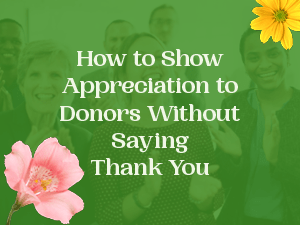
Saying thank you should just be the beginning of your donor appreciation strategy. Here are a few key ideas for showing your gratitude with your actions.
A donor thank-you letter or email is a staple of every nonprofit’s donor communications. These messages let donors know that your organization received their gift and that you appreciate their support.
But your donor thank-you letters should be just the beginning of your supporter stewardship strategy. When you show donors your gratitude in addition to telling them how much you value their engagement, your efforts will feel more genuine and memorable.
Donor appreciation shouldn’t just be a one-time task to complete only after donors give. It should become a fundraising habit at your nonprofit as you express gratitude on a regular basis.
From your major donors to your first-time givers, here are four ways to show appreciation to all your nonprofit’s supporters:
- share impact and progress updates;
- ask for donors’ feedback;
- invite donors to engage in multiple ways; and,
- send an appreciation gift.
These appreciation ideas take your gratitude approach beyond a simple “thank you” to truly show donors that you value their ongoing engagement. Let’s dive in!
Share impact and progress updates
Donors certainly appreciate a thank-you message, but actions speak louder than words. When you show donors you’re using their donations as you said you would, they’ll feel greater trust and respect for your organization. Plus, they’ll feel more inclined to make additional gifts in the future.
In your ongoing donor communications, highlight your nonprofit’s progress updates. Be sure to also provide updates for specific campaigns or projects that donors supported.
For example, share photos and videos of the therapy horse that your organization was able to purchase because of donors’ support. Or, provide a timeline of when your nonprofit expects to finish construction on your new community garden.
In all of your communications, make it clear that none of these advancements would be possible without donors’ support for your fundraising efforts.
Ask for donors’ feedback
Think of a time when someone in your life came to you for advice or guidance. You probably felt grateful that they thought of you as someone to confide in, and it likely made your relationship stronger.
Similarly, asking donors for their feedback shows that you value their opinions and think of them as trusted partners in helping you achieve your mission.
Ask for supporters’ input on different aspects of your organization such as your:
- events;
- volunteer opportunities;
- donation process; and,
- communication frequency.
Gather this feedback using surveys, phone calls, or in-person conversations with donors. Track donors’ responses using your donor management system to maintain a detailed record of your past supporter interactions.
Then, you can use your donor management software to segment donors based on their survey responses. For example, you might send a survey asking donors about their preferred communication platform. You can use this data to create groups for donors who prefer email, direct mail, texts, or phone calls. This helps you personalize your donor outreach and appeal to supporters’ preferences, making it more likely that they’ll see and act on your messages.
Invite donors to engage in multiple ways
Another way to show donors that you appreciate them is to show that you value their ongoing participation. By inviting donors to engage in other aspects of your nonprofit, you can grow your donor relationships and create a stronger donor community.
Additional ways donors can get involved include:
- Exclusive events: Invite donors to participate in a happy hour, a tour of your facilities, or a year-end holiday celebration.
- Volunteer opportunities: Allow donors to see the impact of their donations first-hand by participating in a volunteer opportunity.
- Advocacy opportunities: Invite donors to become influencers or ambassadors for your nonprofit by giving them tips for posting about your cause on social media or hosting their own fundraising event.
Donors will enjoy having other ways to engage with your organization that don’t just involve donating. Plus, they’ll be able to form relationships with other supporters throughout these opportunities, which can show them the additional benefits of staying involved with your organization.
Send an appreciation gift
An appreciation gift can be an unexpected but thoughtful surprise for your donors. You can send donors a gift after they donate or at a special time of the year, like their birthdays.
Bloomerang’s donor appreciation guide recommends offering simple tokens of gratitude like:
- free merchandise such as a t-shirt, calendar, tote bag, water bottle, or bumper sticker;
- a gift basket with a few small items like stickers or sweets; or,
- a discount or coupon book for local businesses.
Another benefit of sending donors a gift like branded merchandise is that when they wear or use your merchandise, they can help market your nonprofit to a wider audience.
Challenging your donor stewardship team to find new ways to thank donors beyond just saying thank you can have long-lasting benefits for your donor retention. You can build stronger, more meaningful relationships through ongoing engagement and gratitude.
- Assess your current donor appreciation approach and find opportunities to incorporate ongoing gratitude efforts.
- Develop a variety of donor surveys that you can send after different interactions or events to collect feedback.
- Create a communication cadence that allows you to keep in touch with donors and send regular updates on your projects and programs.